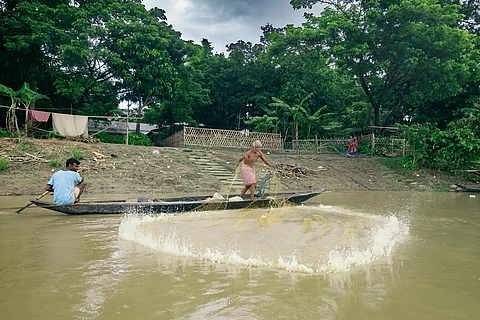

Fishermen in Assam’s Cachar district say they haven’t caught fish from the Barak river in over two months — an unprecedented situation following June’s floods.
Communities that once relied on the river for Hilsa, Rohu and other species are now struggling to survive, with many shifting to manual labour.
Experts suggest that riverbank erosion, sedimentation, and climate-driven weather shifts are altering the river’s ecology — and endangering traditional livelihoods.
For the past 37 years, Abdul Kalam, a fisherman from Madarpur village in Assam’s Cachar district, has never returned empty-handed from the Barak river, which flows beside his home.
But this year’s monsoon, followed by flooding in June, has swept away his only source of livelihood. Since then, he has barely managed a worthwhile catch in two months.
“The river seems empty or barren since the flood,” he said. “Usually, it’s the opposite, floodwaters bring more fish. But this year, there are none.”
Around 900 families live in Madarpur, the majority of whom rely on fishing for sustenance. Fishermen typically spend the early morning hours on the river, rest briefly at midday and return until late evening.
Kalam said that at times they remain on the river until 10 pm. “We usually earn around Rs 100 a day and up to Rs 500 on a good day. But for the past two months, we haven’t even made Rs 20 from a catch,” he said.
He and others say that the only fish available is baby Hilsa. “The river was once full of Rohu (Labeo rohita), Catla (Catla catla), Hilsa (Tenualosa ilisha) and Ritha (Rita rita). Flooding isn’t new to this region, yet the fish have somehow vanished.”
Azad Uddin, another fisherman, aged 46, said he is able to catch fish on just two days in a week, returning empty-handed the other five. “Over the past two months, fish have entered our nets on maybe 20 days in total. On the remaining, nothing.”
He added that the fishermen are not only spending longer hours on the river but are covering far greater distances in search of a catch.
Lilaram Das, a 77-year-old fisherman from neighbouring Niz Haritikar Part I village, said such a situation hasn’t been witnessed in the last 50 years. “Every year, after the floods, we used to earn well because more fish would be available. This year, I’ve taken my boat five kilometres upstream and one kilometre downstream, but it has all been in vain,” he said.
With no income to survive on, many have begun taking up daily wage work at construction sites or doing other forms of manual labour.
Das said the situation is the same for nearly 500 families in his village. “I’ve spent my entire life fishing. I can’t just shift to another job for which I have no skills,” he added.
Uddin, by contrast, said he has started working as a labourer, earning Rs 500 a day. “At least this way I can buy groceries from the market including fish to feed my family,” he said.
But the fishermen remain at a loss as to why the fish have suddenly disappeared.
Some suspect that heavy flows of alluvial soil during the floods may have disrupted fish populations. “Riverbank erosion and widening have been a threat for over a decade and have worsened in recent years,” one fisherman explained. “The widening of riverbanks makes it harder for fish to get caught in our nets.”
A study titled Floodplains Ecosystem Services Survey Report, published earlier this year by researcher Sanat Chakraborty on the Barak-Meghna river basin.The paper was prepared for North-East Affected Areas Development Society (NEADS), an Assam-based organisation that works closely with fishing communities, as part of the Trans-boundary Rivers of South Asia 2.0 project in the Barak river basin with support from the International Union for Conservation of Nature.
Chakraborty noted that the natural hydrological regime and biophysical environment of the Barak river basin have been “substantially altered and degraded” in recent decades. This, the report states, has triggered changes in the floodplain ecosystem’s functions and services.
The paper also said such degradation has led to a decline in freshwater ecosystem services and a loss of aquatic biodiversity in the valley region, severely reducing the carrying capacity of riverine systems.
The report also noted that unpredictable and extreme weather events, driven by climate change, have become the new normal, making it increasingly difficult for ecosystems and the communities that depend on them to cope.
Madhulika Shome, programme lead at NEADS, said the impacts of climate change are now directly affecting society’s primary producers, including farmers and fisherfolk. “This has direct consequences for all sections of society who rely on them to meet their basic needs. I believe it is incredibly difficult for a community or society to progress when such a large portion is deprived of its most fundamental requirements,” Shome added.
A 2023 study by researchers at the University of Glasgow found that many fish species are migrating towards cooler polar waters or deeper parts of the ocean to escape rising temperatures, with some disappearing entirely from their usual habitats.